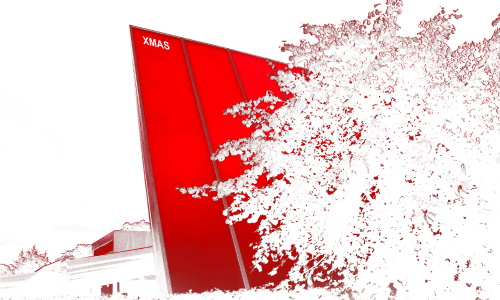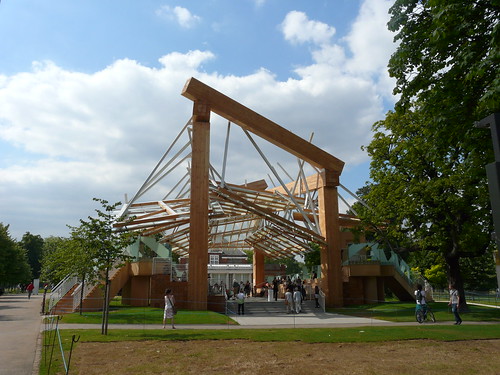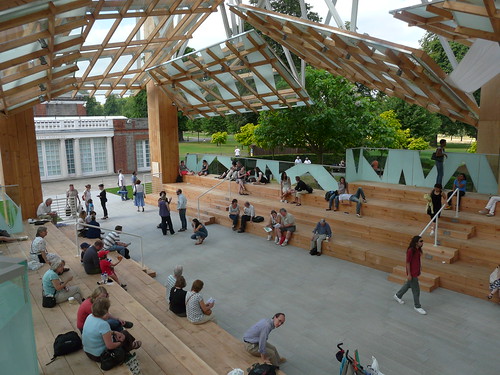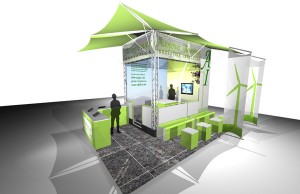The red pavilion at the Serpentine Gallery 2010 by French architect Jean Nouvel converted into an Xmas card. Both are utterly unrestrained in their singular use of red…
Nouvel’s pavilion is red right down to the colour of the dustbins of the refreshment area. Many articles at the time played on the words, ‘seeing red…’ and indeed – red is what you see. Nouvel said, “the red for me is the idea of something very strong, energetic and optimistic” .
I am all for such rigorous creative rule-making, but ultimately I was disappointed by the execution and experience. Once the extent of redness was understood, the idea quickly wanes. In such a bold and radical space we should have expected some kind of sensual transformation, or at least a senses of wonder. No doubt the neuroscientist Beau Lotto would have marveled at this pavilion – a giant recreation of an ideal environment for conducting psychological experiments. He featured in Sophie Robinson’s Horizon programme Do you see the same colour as me?. During the filming they discovered that red slows down time, and affects hormones to reduce stress levels – but I sat for quite a while, sitting on red furniture in a pool of red light – unfortunately, did not feel the benefit of either. This is a shame, as the pavilion might have been advertised as a time-warping tardus or a public chill-out room.
The material of structures is always critical to the success of the building. In this case the unattractive cladding, which appeared to have been borrowed from corporate tensile structures, did little to help the problem. For all the boldness and flamboyance, I was left feeling that if the red was taken out of the equation, we would be left with something not much more interesting than a well-made marquee.
The only other Serpentine Pavilion I have visited is the Frank Gehry Pavilion of 2008. This was a far more substantial and impressive structure. Much was made of the inspiration behind Gehry’s idea – from da Vinci catapults, to English umbrellas. However he arrived at the design, I felt that Gehry had perfectly embraced the idea of a pavilion.
It was a remarkable and very enjoyable space. A space to congregate and contemplate; a theatre for reflection, debate and performance; a promenade from park to gallery. And whatever your perceptions of Gerhy’s art, it cannot be denied that the space was enlivening, dramatic and spiritually uplifting.
We love pavilions at the Bridge. We introduced notions of a pavilion into a trade exhibition stand proposal a year before Gehry’s pavilion. Often very large national stands will be called pavilions – but we wanted to include the spirit of a pavilion in a much smaller and low-cost unit. We used Zaha Hadid’s description of her designs for the UK Pavilion at Expo 2010 competition as a source of inspiration, “…the pavilion is lightweight, open-canopy structure and low-cost. It is also a memorable spectacle: a structure fusing content with architecture, the individual with a crowd, learning with entertainment”.
Our sketches below, were used in our proposal and in hindsight resonate with Gehry’s pavilion. They now form the basis of our Live product offer in three sizes.









